On a clear sunny day, the sky above us looks bright blue. In the evening, sunset colors the sky in red, pink and orange colors. Why the sky is blue? What makes sunset red?
To answer these questions, you need to know what light is and what the atmosphere of the earth consists of.
Atmosphere
The atmosphere is a mixture of gases and other particles surrounding the earth. Basically, the atmosphere consists of gaseous nitrogen (78%) and oxygen (21%). Argon gas and water (in the form of steam, droplets and ice crystals) are the most abundant in the atmosphere, their concentration does not exceed 0.93% and 0.001%, respectively. The atmosphere of the Earth contains small amounts of other gases, as well as the smallest particles of dust, soot, ash, pollen and salt that enters the atmosphere from the oceans.
The composition of the atmosphere varies slightly depending on the location, weather, etc. The concentration of water in the atmosphere increases during rain storms, as well as near the ocean. Volcanoes are capable of throwing huge amounts of ash high into the atmosphere. Man-made pollution can also add to the usual composition of the atmosphere various gases or dust and soot.
The density of the atmosphere at low altitude near the surface of the Earth is greatest, with increasing height it gradually decreases. There is no distinct border between the atmosphere and the cosmos.
Light waves
Light is a type of energy that is carried by waves. In addition to light, waves transfer other types of energy, for example, a sound wave is air vibrations. A light wave is an oscillation of electric and magnetic fields, this range is called the electromagnetic spectrum.
Electromagnetic waves propagate through airless space at a speed of 299.792 km / s. The speed of propagation of these waves is called the speed of light.
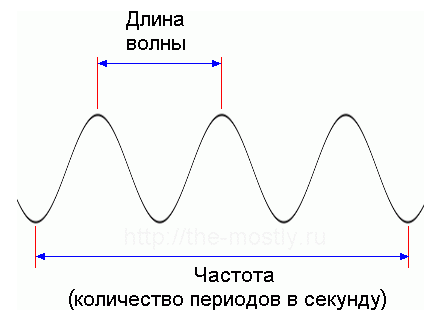
Light wave parameters
The radiation energy depends on the wavelength and its frequency. The wavelength is the distance between the two nearest peaks (or valleys) of the wave. The frequency of the wave is the number of oscillations of the wave per second. The longer the wave, the lower its frequency, and the less energy it carries.
Visible light colors
Visible light is part of the electromagnetic spectrum that can be seen by our eyes. The light emitted by the sun or incandescent lamp may be white, but in fact it is a mixture of different colors. You can see the different colors of the visible spectrum of light, decomposing it into components using a prism. This spectrum can also be observed in the sky in the form of a rainbow, arising from the refraction of the light of the Sun in water droplets acting as one giant prism.

Rainbow
The colors of the spectrum are mixed, continuously moving from one to another. At one end, the spectrum has a red or orange color. These colors smoothly turn into yellow, green, blue, indigo and violet colors. Colors have different wavelengths, different frequencies and differ in energy.
The spread of light in the air
Light travels through space in a straight line until there are no obstacles in its path. When a light wave enters the atmosphere, the light continues to propagate rectilinearly until dust or gas molecules are in its path. In this case, what happens to the light will depend on its wavelength and the size of the particles in its path.
Dust particles and water droplets are much larger than the wavelength of visible light. Light is reflected in various directions in collisions with these large particles. Different colors of visible light are equally reflected by these particles. Reflected light appears white, as it still contains the same colors that were before it.
Gas molecules are smaller than the wavelength of visible light. If a light wave collides with them, then the result of the collision may be different. When light collides with a molecule of a gas, then part of it is absorbed. A little later, the molecule begins to emit light in different directions. The color of the emitted light is the same color that was absorbed. But colors of different wavelengths are absorbed differently. Any colors can be absorbed, but higher frequencies (blue) are absorbed much more than low frequencies (red). This process is called Rayleigh scattering, so named after the British physicist John Rayleigh, who discovered this scattering phenomenon in the 1870s.
Why is the sky blue?
The sky has a blue color due to Rayleigh scattering. As light moves through the atmosphere, most of the long waves of the optical spectrum pass unchanged. Only a small part of the red, orange and yellow colors interact with the air.
However, many shorter waves of light are absorbed by gas molecules. After absorption, the blue color is emitted in all directions. He scatters everywhere in the sky. In whatever direction to look, some of this diffused blue light reaches the observer. Since blue light is visible everywhere above your head, the sky also looks blue.
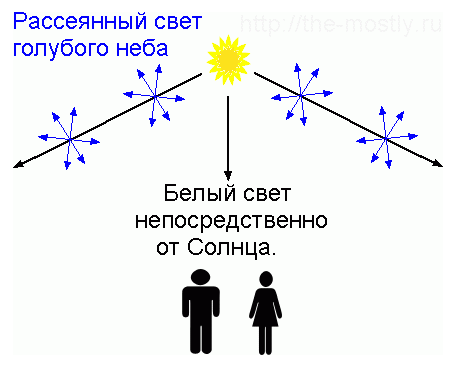
Scattered light blue sky
If you look towards the horizon, the sky will have a paler shade. This is a result of the fact that light travels a greater distance in the atmosphere to the observer. The scattered light is again diffused by the atmosphere, and less blue reaches the eye of the observer. Therefore, the color of the sky at the horizon appears paler or even appears entirely white.
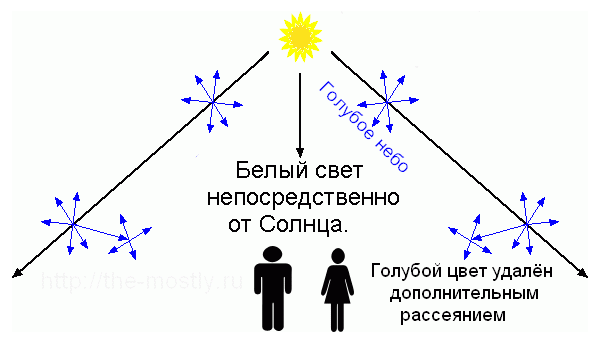
At the horizon the sky is paler
Black sky and white sun
From Earth, the Sun appears yellow. If we were in space or on the moon, then the sun would seem white to us. In space, there is no atmosphere that diffuses sunlight. On Earth, part of the short waves of sunlight (blue and purple) are absorbed by scattering. The rest of the spectrum looks yellow.
In addition, in space, the sky looks dark or black instead of blue. This is the result of the absence of the atmosphere, therefore the light does not diffuse.
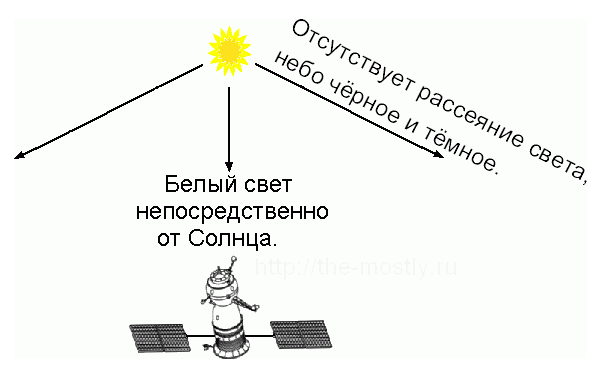
Black sky in space
Why is sunset red?
When the sun goes down at sunset, the sunlight has to travel a greater distance in the atmosphere in order to reach the observer, respectively, more sunlight is reflected and scattered by the atmosphere. Since less direct light reaches the observer, the Sun appears less bright. The color of the sun also seems different; it has a range of colors from orange to red. This is due to the fact that even more shortwave colors, blue and green, are scattered. Only the long-wave components of the optical spectrum remain, which reach the eye of the observer.
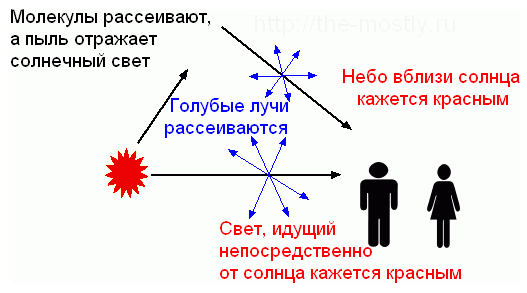
At sunset, the sun appears red
The sky around the setting sun can be colored in different colors. The sky is most beautiful when the air contains many small particles of dust or water. These particles reflect light in all directions. In this case, the scattering of shorter light waves occurs. The observer sees the light rays of longer waves, and therefore the sky appears red, pink or orange.
More about the atmosphere
What is the atmosphere?
The atmosphere is a mixture of gases and other substances that surround the Earth, in the form of a thin, mostly transparent shell. The atmosphere is held in place by the attraction of the Earth. The main components of the atmosphere are nitrogen (78.09%), oxygen (20.95%), argon (0.93%) and carbon dioxide (0.03%). Also in the atmosphere there are small amounts of water (in different places its concentration ranges from 0% to 4%), particulate matter, gases neon, helium, methane, hydrogen, krypton, ozone and xenon. The science that studies the atmosphere is called meteorology.
Life on Earth would be impossible without an atmosphere that supplies the oxygen we need for breathing. In addition, the atmosphere performs another important function - it levels the temperature across the planet. If there was no atmosphere, in some places of the planet there could be heat sizzling, and in other places there would be extreme cold, the temperature range could range from -170 ° C at night to + 120 ° C during the day. The same atmosphere protects us from the harmful radiation of the Sun and the cosmos, absorbing and scattering it.
About 30% of the total energy of the Sun reaching the Earth is reflected by clouds and the earth's surface back into space. The atmosphere absorbs approximately 19% of the Sun’s radiation, and only 51% is absorbed by the Earth’s surface.
Air has weight, although we are not aware of this, and do not feel the pressure of the air column. At sea level, this pressure has a size of one atmosphere, or 760 mm Hg (1013 millibar or 101.3 kPa). With increasing altitude, atmospheric pressure rapidly decreases. The pressure drops 10 times with increasing height for every 16 km. This means that at a pressure of 1 atmosphere at sea level, at an altitude of 16 km, the pressure will be 0.1 atm, and at an altitude of 32 km - 0.01 atm.
The density of the atmosphere in its lowest layers is 1.2 kg / m3. Each cubic centimeter of air contains approximately 2.7 * 1019 molecules. At ground level, each molecule moves at a speed of about 1600 km / h, and the frequency of collisions with other molecules is 5 billion times a second.
Air density also drops rapidly with increasing altitude. At an altitude of 3 km, the air density decreases by 30%. People living near sea level when elevated to such an altitude experience temporary breathing problems. The greatest height at which people reside is 4 km.
Atmosphere structure
The atmosphere consists of different layers, the division into these layers occurs according to their temperature, molecular composition and electrical properties. These layers have no pronounced boundaries, they change seasonally, and in addition, their parameters vary at different latitudes.
Atmosphere layers
The separation of the atmosphere into layers depending on their molecular composition
- Homosphere
- Lower 100 km, including the Troposphere, Stratosphere and Mesopause.
- It is 99% of the mass of the atmosphere.
- Molecules are not separated by molecular weight.
- The composition is fairly uniform, with the exception of some small local anomalies. Uniformity is maintained by constant mixing, turbulence, and turbulent diffusion.
- Water is one of two components distributed unevenly. When water vapor rises, it cools and condenses, then returning to earth in the form of precipitation — snow and rain. The stratosphere itself is very dry.
- Ozone is another molecule whose distribution is uneven. (Read about the ozone layer in the stratosphere below.)
Hetero sphere
- Homosphere extends above, includes the Thermal Sphere and the Ecosphere.
- The separation of the molecules of this layer is based on their molecular masses. Heavier molecules, such as nitrogen and oxygen, are concentrated in the lower part of the layer. Lighter ones, helium and hydrogen, predominate in the upper part of the heterosphere.
The division of the atmosphere into layers, depending on their electrical properties
Neutral atmosphere
- Below 100 km.
Ionosphere
- Approximately above 100 km.
- Contains electrically charged particles (ions) arising from the absorption of ultraviolet light
- The degree of ionization varies with altitude.
- Different layers reflect long and short radio waves. This allows radio signals propagating in a straight line to bend around a spherical surface of the earth.
- In these atmospheric layers there are auroras.
Magnetosphere is the upper part of the ionosphere, stretching to about 70,000 km altitude, this height depends on the intensity of the solar wind. The magnetosphere protects us from the charged particles of the high energy of the solar wind, keeping them in the magnetic field of the Earth.
The division of the atmosphere into layers depending on their temperatures
The height of the upper boundary of the troposphere depends on the seasons and latitude. It extends from the earth’s surface to an altitude of about 16 km at the equator, and to an altitude of 9 km at the North and South Poles.
The prefix tropo means change. Changing the parameters of the troposphere is due to weather conditions - for example, due to the movement of atmospheric fronts.
With increasing altitude, the temperature drops. Warm air rises, then cools and descends back to Earth. This process is called convection, it arises as a result of the movement of air masses. The winds in this layer blow mostly vertically.
This layer contains more molecules than all other layers combined.
Stratosphere - extends approximately from an altitude of 11 km to 50 km.
- It has a very thin layer of air.
- The strato prefix refers to layers or layering.
- The lower part of the stratosphere is quite calm. Jet planes often fly in the lower part of the stratosphere in order to get around bad weather in the Troposphere.
- In the upper part of the Stratosphere strong winds blow, known as high-altitude jet streams. They blow horizontally at speeds up to 480 km / h.
- The stratosphere contains the "ozone layer", located at an altitude of about 12 to 50 km (depending on latitude). Although the concentration of ozone in this layer is only 8 ml / m3, it very effectively absorbs the harmful ultraviolet rays of the sun, thereby protecting life on earth. The ozone molecule consists of three oxygen atoms. The oxygen molecules that we breathe contain two oxygen atoms.
- The stratosphere is very cold, its temperature is about -55 ° C in the lower part and increases with altitude. The increase in temperature is due to the absorption of ultraviolet rays by oxygen and ozone.
Mesosphere - extends to heights of about 100 km.
- With increasing altitude, the temperature is rising rapidly.
- Thermosphere - extends to altitudes of about 400 km.
- As the altitude increases, the temperature quickly increases due to the absorption of very short-wave ultraviolet radiation.
- Meteors, or "shooting stars", begin to burn at altitudes of about 110-130 km above the Earth's surface.
Exosphere - extends hundreds of kilometers beyond the Thermosphere, gradually moving into outer space.
- The density of air here is so low that the application of the concept of temperature loses all meaning.
- When colliding with each other, molecules often fly into space.
Light experiments
The first experiment - the decomposition of light in the spectrum
To conduct this experiment you will need:
- a small mirror, a piece of white paper or cardboard, water;
- a large small vessel; types of cuvettes or bowls, or a plastic ice cream box;
- sunny weather and a window overlooking the sunny side.
How to conduct an experiment:
- Fill a cuvette or bowl for 2/3 with water and place it on the floor or table so that direct sunlight reaches the water. The presence of direct sunlight is mandatory for the proper conduct of the experiment.
- Place the mirror under the water so that the sun would fall on it. Hold a piece of paper above the mirror so that the sun's rays reflected by the mirror hit the paper, if necessary, adjust their relative position. Watch the color spectrum on paper.

Experiment with the decomposition of light on the spectrum
What happens: water and a mirror act like a prism, decomposing light into the color components of the spectrum. This is because the rays of light, passing from one medium (air) to another (water), change their speed and direction. This phenomenon is called refraction. Different colors are refracted in different ways, the violet rays are more inhibited and more strongly change their direction. Red rays slow down and change their direction to a lesser extent. Light is divided into component colors, and we can see the spectrum.
Simulation of the sky in a glass jar
Materials required for the experiment:
- transparent tall glass or clear plastic or glass jar;
- water, milk, a teaspoon, a flashlight;
- a dark room;
Conduct an experiment:
- Fill a glass or jar for 2/3 with water, about 300-400 ml.
- Add in water from 0.5 to one spoon of milk, mix the mixture.
- Taking a glass and a flashlight, go into the dark room.
- Hold the flashlight over a glass of water and direct the beam of light to the surface of the water, look at the glass from the side. In this case, the water will have a bluish tint. Now point the flashlight at the side of the glass, and look at the beam of light from the other side of the glass, so that the light passes through the water. In this case, the water will appear a reddish tint. Place a flashlight under the glass and direct the beam of light up, while looking at the water from above. In this case, the reddish tint of the water will look more saturated.
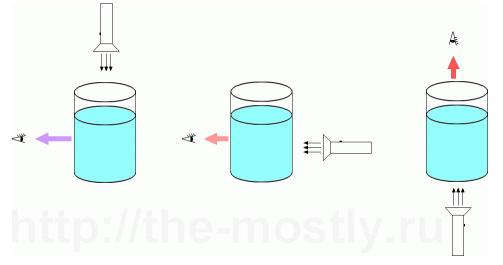
Modeling the scattering of sunlight in a can of water
What happens in this experiment: small particles of milk suspended in water scatter the light coming from the flashlight in the same way as particles and molecules in the air scatter sunlight. When the glass is illuminated from above, the water appears bluish due to the fact that the blue color is scattered in all directions. When you look directly at the light through the water, the light of the flashlight appears to be red, as part of the blue rays have been removed due to the scattering of light.
Mixing colors
You will need:
- pencil, scissors, white cardboard or a piece of drawing paper;
- colored pencils or felt-tip pens, ruler;
- a cup or a large cup with a diameter in the upper part of 7 ... 10 cm or a vernier caliper.
- paper cup.
How to conduct an experiment:
- If there is no caliper, then use the circle as a template for drawing a circle on a piece of cardboard, cut this circle. Using the ruler, divide the circle into 7 approximately equal sectors.
- Paint these seven sectors in the basic spectrum colors — red, orange, yellow, green, blue, blue, and purple. Try to color the disk as neat and evenly as possible.
- Make a hole in the middle of the disc and slide the disc onto the pencil.
- Make a hole in the bottom of the paper cup, the diameter of the hole should be slightly larger than the diameter of the pencil. Turn the cup upside down and insert a pencil into it with the mounted disk so that the pencil lead rests on the table, adjust the position of the disk on the pencil so that the disc does not touch the bottom of the cup and is above it at a height of 0.5..1,5 cm.
- Quickly unwind the pencil and look at the rotating disk, pay attention to its color. If necessary, adjust the disc and pencil so that they can rotate easily.

Color Mixing Experiment
Explanation of the seen phenomenon: the colors that color the sectors on the disk are the main components of the colors of white light. When the disk rotates fast enough, it seems that the colors merge and the disk looks white. Try experimenting with other color combinations.
Publication: the-mostly.ru
Read and write useful
Why the sky is blue?
There are many answers)))
The sun is reflected from our planet, and since 70% of water is on it (that is, blue space), so somewhere in the troposphere there is a reflection blue!
And at night, when there is nothing to reflect, you see the cosmos! ;
The atmosphere has this property to let the blue shades out of the whole spectrum of white light ....
Why is the sun at sunset red ....
for the same reason, only the spectrum of others ....
angles of incidence and refraction are different ....
The composition of the atmosphere is such that the sun's rays are refracted in it and the blue part of the spectrum reaches us
Unfortunately, all previous answers are wrong, sorry. The gases that are part of the air simply scatter blue rays (like glass, which can be seen as green, yellow or another depending on the composition). The red and ultraviolet rays transmit a clean atmosphere, and the Sun is red on the horizon due to the large amount of dust. and other particles, but the atmosphere is not to blame, By the way, Soltse itself is a yellow ordinary star.
The question “why is the sky blue?” Can be safely classified as the most standard physical questions. Physicists usually shrug it off, mumbling something about Rayleigh scattering.
But this question undoubtedly deserves more attention. What part of the sky, for example, is painted in the brightest blue color; why not all the sky has the same shade? Does the color of the day sky match the predicted Rayleigh theory? Why is the night sky with a full moon not blue? What is the light of the sunlight that creates the blue color of the day sky? Would the sky be as blue if the particles on which scattering occurs were much larger or much smaller? Why, finally, is the sky on Mars blue only within a few degrees above the horizon, while the rest of it is black?
The sun sends its rays to the earth, but they have to make their way through a thick layer of air that envelops the earth. And the sunbeam is multicolored, it consists of
red,
orange
yellow
green
blue
blue
purple
colors.
And so, when this multicolor beam passes through a thick layer of air, air particles scatter, spray all the colors of the solar spectrum, but most of all, the violet, blue and blue parts are most powerful. Therefore, the sky is painted in blue. The blue color of the sky is the blue spray of a multicolored sunbeam.
Sunlight flying straight from the sun to you is white. Therefore, the sun itself you see white, and a portion of the sky around it. But in all other points of the sky you see blue. There is only one reason: from all points of the sky, blue rays reach you. The fact is that sunny white is actually a “mixture” of hundreds of millions of rays of different colors. And the molecules of atmospheric gas most scatter (that is, reflect in different directions, "scatter") the rays that are closest to blue. The rest of the rays pass through.
This happens because the wavelength of the blue beam is comparable to the size of the air molecules themselves. The wavelength of the red rays is much more - they just go around the air particles. And the wavelength of violet and ultraviolet - less, they pass through. And the blue ones are dissipating. Therefore, from every point of the atmosphere blue rays reach you. The result is that you see a big blue sky.
There lived a Sunlight in the Sun, white, very white. And he had seven sons — red, orange, yellow, green, blue, blue, and purple. When they grew up, it was time for them to leave their father's house and go to Earth, because it was the sun that gives the earth the necessary heat and light.
The father began to instruct his children:
-To fall on Earth is not so easy, you have a lot to see. Do not forget that you are parts of one whole - me ...
As they did not want to leave their native Sun, they had to go on a journey. While the brothers flew to the earth and were together, they were a bright white light, just like their father.
They flew up to the Earth and see that it is enclosed in a transparent shell, and they can’t go through it all together. Then the brothers had to separate and get to the surface of the earth on their own. While they were flying, something they just didn’t see: particles of various gases were hurrying past them in their business, it was important that ice crystals walked around, tiny suspicious dust particles flashed through them. It was the Atmosphere, the mysterious city of the heavenly inhabitants.
Red, orange and yellow brothers, without being distracted by anything, quickly got to the surface. Green, blue and purple decided to linger a little in the Atmosphere. But they soon got tired of stumbling on its completely identical inhabitants, and they hurried after their brothers to the surface.
And only the brother of blue did not want to join them so quickly. He walked slowly through the Atmosphere, bowing with particularly pretty crystals or avoiding suspicious specks of dust. He just liked to soar above and look down on the dark earth. But now it is time for him to descend. On the way, he met the beam, as two drops similar to it. They looked at each other knowingly and went their separate ways.
And now every time, looking up at the blue sky, we see blue rays traveling through the mysterious Atmosphere.
Heavenly blue is one of the manifestations of the scattering of light. It turns out that the blue rays falling to the Earth from the Sun are scattered by air molecules about 6 times stronger than their “antagonists” in the visible spectrum - red, and therefore the sky looks blue, and the sun is redder than it is closer to the horizon.
That is how the blue color of the sky in 1871 was explained by the famous English mathematician and physicist John William Strett, who inherited from his father the title of Lord Rayleigh almost at the same time, and since then the scattering of light on individual atoms or molecules and in general on small particles - with sizes much smaller than the length light wave, called Rayleigh.
What is the reason that the blue rays are scattered in the atmosphere much more red? The fact is that a ray of light is an electromagnetic wave (more precisely, a set of waves), the electric field of which periodically changes - oscillates - and causes the electron cloud oscillating with the same frequency, surrounding the atom. But at the same time, oscillating electrons themselves become sources of secondary electromagnetic waves.
There is no atmosphere on the moon, and the sky looks black. When a spacecraft goes into orbit beyond the atmosphere, astronauts see glittering stars and planets reflecting their light in the black velvet sky.
To answer these questions, you need to know what light is and what the atmosphere of the earth consists of.
Light waves
Shine is a variation energytransported using waves. A light wave is an oscillation of electric and magnetic fields, this range is called electromagnetic spectrum.
Electromagnetic waves spread through airless space at a speed of 299,792 km / s. The speed of propagation of these waves is called the speed of light.
Radiation energy depends on wavelength and her frequencies. Wavelength - this is the distance between the two nearest peaks (or valleys) of the wave. Frequency the waves - This is the number of oscillations of a wave per second. The longer the wave, the lower its frequency, and the less energy it carries.
Visible light colors
Visible light is part of the electromagnetic spectrum that can be seen by our eyes. Light from the sun or incandescent lamp appears white, although in reality it is a mixture of all colors. Primary colorsof which white color is composed red, orange, yellow, green, blue, blue and purple. These colors continuously transform into one another, so besides the primary colors there is still a huge number of various shades. All these colors and shades can be observed on the sky in the form of a rainbow that occurs in the area of high humidity. Rainbow arises from the refraction of the light of the Sun in droplets of water, acting as one giant prism.

You can see different colors visible spectrum light, decomposing it into components using a prism. The colors of the spectrum are mixed, continuously moving from one to another. At one end, the spectrum has a red or orange color. These colors smoothly turn into yellow, green, blue, blue and purple. Colors have different wavelengths, different frequencies and differ in energy.
The spread of light in the air
Shine spreads through space in a straight line as long as there are no obstacles in his path. When a light wave enters the atmosphere, the light continues to propagate rectilinearly until dust or gas molecules are in its path. In this case, what happens with the light will depend on its wavelength and the size of the particles in its path.
Dust particles and water droplets are much larger than the wavelength of visible light. Light is reflected in various directions in collisions with these large particles. Different colors of visible light are equally reflected by these particles. Reflected light appears white, as it still contains the same colors that were in it before the reflection.
Gas molecules are smaller than the wavelength of visible light. If a light wave collides with them, then the result of the collision may be different. When light collides with a molecule of a gas, then part of it is absorbed. A little later, the molecule begins to emit light in different directions. The color of the emitted light is the same color that was absorbed. But colors of different wavelengths are absorbed differently. Any colors can be absorbed, but higher frequencies (blue) are absorbed much more than low frequencies (red). This process is called rayleigh scatteringIt is named after the British physicist John Rayleigh, who discovered this scattering phenomenon in the 1870s.
Why the sky is blue?
The sky has a blue color due to Rayleigh scattering. As light moves through the atmosphere, most of the long waves of the optical spectrum pass unchanged. Only a small part of the red, orange and yellow colors interact with the air.
The air filling the entire sky is a mixture of the smallest gas molecules and small solids, such as dust.
As sunlight passes through the air, it stumbles across molecules and dust. When light collides with gas molecules, light can be reflected in different directions. Some colors, such as red and orange, directly reach the observer, directly passing through the air. But most of the blue light is re-reflected from air molecules in all directions. In this way blue light is scattered all over the sky and it appears blue.
When we look upwards, some of this blue light reaches our eyes from all the ends of the sky. Since we see the color blue all over our heads, the sky looks blue.
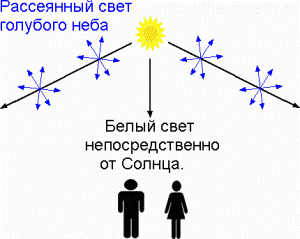
If you look towards the horizon, the sky will have a paler shade. This is a result of the fact that light travels a greater distance in the atmosphere to the observer. The scattered light is again diffused by the atmosphere, and less blue reaches the eye of the observer. Therefore, the color of the sky at the horizon appears paler or even appears entirely white.
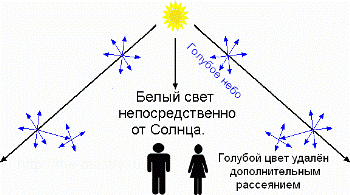
Black sky and white sun
From Earth, the Sun appears yellow. If we were in space or on the moon, then the sun would seem white to us. In space, there is no atmosphere that diffuses sunlight. On Earth, part of the short waves of sunlight (blue and purple) are absorbed by scattering. The rest of the spectrum look yellow.
In addition, in space, the sky looks dark or black instead of blue. This is the result of a lack of atmosphere. There is no air in outer space. Since there are no obstacles from which the light could reflect, the light propagates directly. Rays of light are not scattered, and the "sky" looks dark and black.
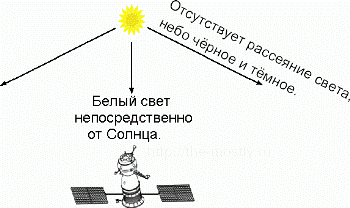
Why is sunset red?
When the sun goes down at sunset, the sunlight has to travel a greater distance in the atmosphere in order to reach the observer, respectively, more sunlight is reflected and scattered by the atmosphere. Since less direct light reaches the observer, the Sun appears less bright. The color of the sun also seems different; it has a range of colors from orange to red. This is due to the fact that even more shortwave colors, blue and green, are scattered. Only the long-wave components of the optical spectrum remain, which reach the eye of the observer.
The sky around the setting sun can be colored in different colors. The sky is most beautiful when the air contains many small particles of dust or water. These particles reflect light in all directions. In this case, the scattering of shorter light waves occurs. The observer sees the light rays of longer waves, and therefore the sky appears red, pink or orange.
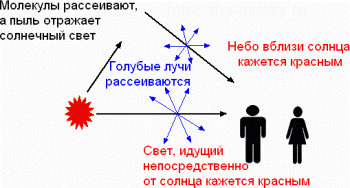
Many wonder, why is the sky still blue? For whatever reason, the sky above our heads acquires this color, which is sometimes very juicy and pronounced. It would seem that there are no prerequisites for the sky to acquire this color, it simply does not exist, because the infinite space, as is known, is a dark space, and darkness has a black color. The sun radiates a dazzling white color. If we proceed from this, the sky should be either black or white, but in fact we see different shades of blue and blue. What is the reason?
For centuries, perhaps even millennia, prominent minds struggled with this question, until finally the answer was not received. To explain how much the sky gets blue or blue, it's worth remembering about the rainbow. Surely, all of you have seen this colorful arc, which can be found in the sky or low above the ground after the rain. The rainbow clearly shows us that the light of the sun is actually multicolored. White light is a mixture of multi-colored rays that break up into individual colors after rain or in air with high humidity. It is in the properties of white light, which radiates the sun, that the secret of the blue sky consists.
As you know, white light consists of seven colors at once: red, orange, yellow, green, blue, blue and violet. By the way, all colors can be learned with the help of one child's count: Every Hunter Wants to Know Where the Pheasant Is Sitting. If white light is passed through a prism, which is the air with high humidity, the light is divided into colors. And if we combine these colors, we will get a white light, which, unlike the long-established “colorless” in our consciousness, is “multicolored”. Using these conclusions, the English physicist Lord John Rayleigh, a hundred years ago, first proposed a theory that turned out to be correct. Then the English physicist suggested that the light of the sun, refracted in the atmosphere of the earth, disintegrates into all seven constituent colors, but for some reason all colors except blue disappear or deviate, but the blue rays fall to the ground. Depending on the position of the sun, we can see rays of different colors, for example, at sunset or sunrise, we see a yellow or red sky that has the same nature of origin. This is called sky diffusion. When dispersed in the atmosphere, the surface of the earth reaches only two thirds of the sunlight.
In 1869, English physicist John Tyndall assumed that light, entering the atmosphere of the earth, collides with the smallest particles and molecules, as a result of which it scatters, and only blue rays reach the Earth’s surface. He proved the whole theory by experiment, illuminating the model of smog or smoke with white light, as a result of which the smoke turned bright blue. This happened for the reason that the rays of violet and blue have the shortest wavelength and are more diffuse than the others. The violet rays in the white color of the sunlight are not so much as the blue ones, so we see that the sky gets exactly the blue hue.
Blue sky photo

![]()


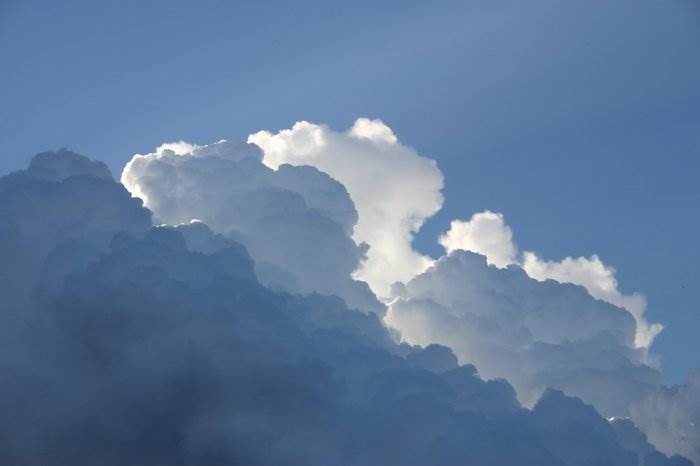
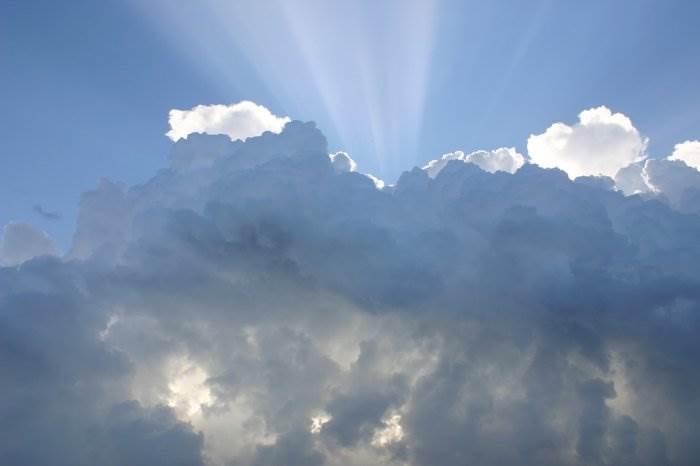

Do you want to buy a beautiful decoration of religious themes? On the website "Church Silver" you can find men's pendants in a large assortment. In addition, crosses, chains, obrakki, rings, earrings and more.